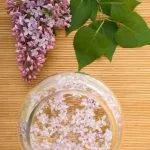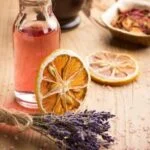Are you looking for a way to take your bath time to the next level? One of the best ways to do so is by learning how to blend aromatherapy oils in bath water.
Aromatherapy oils, also known as essential oils, are highly concentrated plant extracts that have been used for centuries for their therapeutic and healing properties. When added to bath water, these oils can provide numerous benefits, including relaxation, relief from stress and anxiety, and even improving skin health.
There are countless types of aromatherapy oils available, each with its own unique properties and benefits. Choosing the right oils to blend in your bath water is essential for achieving the desired effects. However, it’s important to consider safety precautions when using aromatherapy oils in bath water. By following proper blending techniques and understanding recommended blends for different purposes such as relaxation or energizing, you can create a luxurious aromatherapy bath experience that meets your individual needs.
In addition to blending techniques and safety precautions, incorporating other ingredients into your bath water can enhance the overall aromatherapy experience. Whether you’re looking to create a soothing atmosphere or an invigorating soak, knowing the tips for a luxurious aromatherapy bath will help you make the most of your at-home spa experience.
So if you’re ready to elevate your self-care routine and indulge in some much-needed relaxation, read on to discover how blending aromatherapy oils in bath water can benefit both your body and mind.
Choosing the Right Aromatherapy Oils
Aromatherapy oils are natural plant extracts that have been used for centuries to promote health and well-being. When added to bath water, these oils can create a soothing and therapeutic experience, offering a range of benefits such as relaxation, rejuvenation, and stress relief. However, it is important to choose the right aromatherapy oils for blending in bath water in order to maximize their effectiveness.
When selecting aromatherapy oils for bath water blends, it’s essential to consider their unique properties and the benefits they offer. Here are some popular types of aromatherapy oils and their properties:
- Lavender oil: Known for its calming and relaxing properties, lavender oil is perfect for promoting a sense of tranquility and reducing anxiety.
- Eucalyptus oil: With its refreshing and invigorating scent, eucalyptus oil is ideal for relieving congestion and clearing the mind.
- Peppermint oil: This cooling and refreshing oil can help alleviate headaches and muscle soreness while providing an energizing effect.
- Chamomile oil: Renowned for its soothing and anti-inflammatory properties, chamomile oil is great for calming the skin and promoting relaxation.
Now that you have an understanding of different types of aromatherapy oils, it’s time to learn how to blend them effectively in bath water for maximum benefits. Below are some techniques on how to blend aromatherapy oils in bath water:
- Dilute the essential oils with a carrier oil such as jojoba or almond oil before adding them to bath water.
- Use no more than 5-10 drops of essential oil per bath to avoid overwhelming the senses or causing skin irritation.
- Mix the chosen aromatherapy oils together in a small container before adding them to the bath water to ensure they are evenly distributed.
By following these blending techniques, you can create personalized blends that cater to your specific needs and preferences. Whether you’re looking to unwind after a long day or boost your energy levels in the morning, choosing the right aromatherapy oils is key to achieving a truly luxurious and therapeutic bath experience.
Safety Precautions
Blending aromatherapy oils in bath water can be a wonderful way to relax and rejuvenate, but it’s essential to take some safety precautions into consideration before doing so. Aromatherapy oils are highly concentrated substances that can have potent effects on the body and mind, so it’s important to handle them with care.
First and foremost, it’s crucial to remember that not all essential oils are safe for use in bath water. Some oils may cause skin irritation or allergic reactions, especially when used in high concentrations.
Before blending any aromatherapy oils in your bath water, make sure to research their individual properties and potential side effects. It’s also a good idea to perform a patch test on a small area of your skin to check for any adverse reactions before using the blend more widely.
Another important safety measure is to dilute the aromatherapy oils properly before adding them to your bath water. Essential oils should never be applied directly to the skin or added undiluted to bath water, as this can lead to irritation and sensitivity. Instead, mix the essential oil with a carrier oil such as coconut oil or jojoba oil before incorporating it into your bath water.
Finally, always consult with a healthcare professional if you have any underlying health conditions or concerns about using aromatherapy oils in your bath water. Some essential oils may interact with certain medications or exacerbate existing health issues, so it’s best to seek professional advice if you’re unsure about their suitability for you.
| Safety Precautions | Considerations |
|---|---|
| Research individual properties of essential oils | Check for potential side effects |
| Dilute essential oils properly | Mix with carrier oil before adding to bath water |
| Consult healthcare professional | If you have underlying health conditions or concerns |
Blending Techniques
Blending aromatherapy oils in bath water can be a simple yet effective way to enhance your bathing experience. The key to successfully blending aromatherapy oils lies in understanding the properties of each oil and how they can work together to promote relaxation, energy, or other desired effects. Here are step-by-step instructions on how to effectively blend aromatherapy oils in bath water for maximum benefits.
Step 1: Choose Your Aromatherapy Oils
Start by selecting two or three different types of essential oils with complementary properties. For example, lavender oil is known for its calming and relaxing effects, while eucalyptus oil can provide an invigorating and refreshing sensation. Consider the purpose of your bath – whether it’s for relaxation, rejuvenation, or relief from muscle tension – and choose oils that align with your intentions.
Step 2: Dilute the Oils
Once you have chosen your essential oils, it’s crucial to dilute them before adding them to your bath water. Since essential oils are highly concentrated, mixing them directly into the bath could cause skin irritation. To dilute the oils, mix a few drops of each essential oil with a carrier oil such as jojoba, sweet almond, or coconut oil.
Step 3: Blend the Oils
After diluting the essential oils, blend them together thoroughly to create a well-balanced combination. You can do this by gently stirring the diluted oils together in a small dish or container before adding them to your bath water.
By following these simple steps, you can easily blend aromatherapy oils in bath water to create a personalized and therapeutic bathing experience tailored to your specific needs.
| Blending Techniques | Aromatherapy Oils |
|---|---|
| Choose Your Aromatherapy Oils | Lavender oil for relaxation |
| Dilute the Oils | Mix with carrier oil like jojoba or sweet almond |
| Blend the Oils | Gently stir together diluted oils in a small dish or container |
Recommended Blends
Aromatherapy oils can be blended together to create unique and personalized combinations that cater to specific needs and preferences. Whether you are looking to relax, energize, or soothe your mind and body, there are various recommended blends that you can try for a rejuvenating bath experience. Understanding the properties of different aromatherapy oils is essential in creating the perfect blend for your desired outcome.
For relaxation, consider blending lavender and chamomile essential oils. Lavender is known for its calming and soothing properties, while chamomile has a gentle, floral scent that promotes relaxation. This combination can help alleviate stress and anxiety, allowing you to unwind after a long day. Simply add a few drops of each oil to your bath water and allow the aroma to envelop you as you soak.
If you’re in need of an energy boost, combining peppermint and eucalyptus essential oils can provide an invigorating experience. Peppermint has a refreshing scent that helps to stimulate the mind and body, while eucalyptus provides a cooling effect that can enhance mental clarity. This blend is perfect for when you need a pick-me-up or want to feel revitalized after a tiring day.
For soothing tired muscles and promoting relaxation, try blending rosemary and juniper berry essential oils. Rosemary has analgesic properties that may help relieve muscle pain and tension, while juniper berry offers a warm and woody aroma that contributes to overall relaxation. Together, these oils can create a calming and comforting bath experience.
Experimenting with different aromatherapy oil blends allows you to customize your bath time ritual according to your mood and wellness needs. By understanding the unique properties of each oil, you can create personalized blends that cater to your specific desires for relaxation, energizing, or soothing effects in your bath water.
Incorporating Other Ingredients
When it comes to enhancing the aromatherapy experience in bath water, there are a variety of additional ingredients that can be incorporated to create a luxurious and rejuvenating soak. These ingredients can complement the aromatherapy oils and provide additional benefits for the mind and body.
Epsom Salt
One popular ingredient to add to bath water is Epsom salt. This mineral compound, made up of magnesium and sulfate, is known for its ability to promote relaxation and soothe sore muscles. When combined with aromatherapy oils, Epsom salt can enhance the overall therapeutic effects of the bath.
Dried Herbs and Floral Petals
Adding dried herbs or floral petals to the bath water can create a sensory experience that complements the aromatherapy oils. Lavender flowers, rose petals, chamomile, and mint are just a few examples of botanicals that can be used to enhance the visual appeal and fragrance of the bath.
Baking Soda
Baking soda is another versatile ingredient that can be added to bath water. It has skin-soothing properties and can help to neutralize chlorine in the water. When combined with aromatherapy oils, baking soda can create a calming and gentle bathing experience.
By incorporating these additional ingredients into your aromatherapy bath routine, you can elevate the overall experience and indulge in a truly luxurious self-care ritual. Experiment with different combinations to find what works best for you, taking into consideration any allergies or sensitivities you may have.
Tips for a Luxurious Aromatherapy Bath
Creating the perfect ambiance is essential for a truly luxurious and relaxing aromatherapy bath experience. Here are some tips to help you set the mood for ultimate relaxation:
Dim Lighting
Dimming the lights in your bathroom can instantly create a soothing and calming atmosphere. Consider using candles or installing a dimmer switch to achieve the perfect level of lighting for your aromatherapy bath. Soft, flickering candlelight can enhance the overall ambiance and promote relaxation.
Soft Music
Music can have a powerful impact on your emotional state. Choose soft, instrumental music or nature sounds to create a tranquil environment. The gentle sounds of a piano or the calming rhythm of ocean waves can help melt away stress and tension, allowing you to fully unwind during your aromatherapy bath.
Aromatherapy Diffuser
In addition to blending essential oils in your bath water, consider using an aromatherapy diffuser in your bathroom to further enhance the therapeutic benefits of the oils. Diffusing essential oils such as lavender, chamomile, or ylang-ylang can help promote relaxation and create a serene atmosphere.
By incorporating these elements into your bathing routine, you can elevate your aromatherapy bath experience and indulge in a truly luxurious and rejuvenating self-care ritual. Remember that everyone’s preferences vary when it comes to creating ambiance, so feel free to experiment with different elements until you find what works best for you and enhances your overall relaxation experience.
Conclusion and Final Thoughts
In conclusion, blending aromatherapy oils in bath water can be a wonderful way to elevate your bathing experience and promote overall well-being. The benefits of using aromatherapy oils in bath water are numerous, including relaxation, rejuvenation, and enhancing mood. By choosing the right aromatherapy oils and following safety precautions, individuals can create personalized blends to suit their needs and preferences.
When considering how to blend aromatherapy oils in bath water, it is important to keep in mind the unique properties of each oil and how they work together. Whether you are looking to relax after a long day, boost your energy levels in the morning, or soothe sore muscles, there are recommended blends for every purpose. Experimenting with different combinations can help you find the perfect blend that resonates with you and provides the desired effects.
Incorporating other ingredients such as Epsom salt or coconut oil can further enhance the benefits of an aromatherapy bath. These additional elements can complement the effects of the essential oils and create a truly luxurious bathing experience.
Overall, blending aromatherapy oils in bath water offers a holistic approach to self-care and relaxation that is worth exploring for anyone seeking natural methods to improve their well-being. So go ahead and give it a try – your mind, body, and spirit will thank you.
Frequently Asked Questions
How Do You Mix Essential Oils in Bath Water?
To mix essential oils in bath water, you can first dilute them in a carrier oil or an emulsifier like honey or milk before adding them to the bath. This helps disperse the oils evenly in the water and prevents irritation.
Can You Mix Aromatherapy Oils With Water?
Aromatherapy oils can be mixed with water, but it’s important to use a dispersant or emulsifier to help the oils mix properly. Simply adding essential oils to water can cause them to float on top and potentially cause skin irritation.
How Do You Emulsify Oil in a Bath?
Emulsifying oil in a bath involves using a carrier oil or an emulsifier like liquid Castile soap to disperse the essential oils evenly in the water. This helps prevent the oils from floating on top and makes for a more enjoyable bath experience.

Are you looking for a natural way to improve your health and wellbeing?
If so, aromatherapy may be the answer for you.





